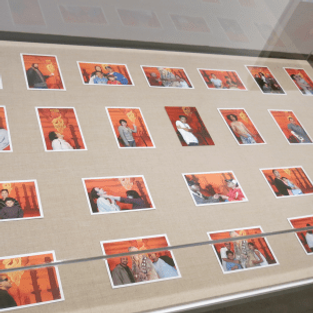Call and Response at CSU Long Beach
- artandcakela
- Apr 7, 2019
- 5 min read
Updated: Jan 27

Abel Alejandre, Call and Response, University Art Museum CSULB; Photo credit Amanda Fruta
Call and Response Evokes Visceral Responses to Art
through April 14 University Art Museum at California State University, Long Beach
Written by Genie Davis What is a call and response? It is a revival of sorts, it is a conversation that demands reciprocation. And that is precisely what viewers get at the University Art Museum at Long Beach State University. In a large and inclusive exhibition, Call and Response, When We Say… You Say, incorporates works from the university’s art collection and “responses” to that work created by the Wilmington-based art collective Slanguage. The list of participating artists alone is enough to excite. University art collection artists include Kim Abeles, Richard Bosman, Patricio Cabrera, Albert Contreras, Adolph Gottlieb, Graciela Iturbide, Piotr Kowalski, Lee Krasner, Ken Light, Ken Price, Lorna Simpson, and Andy Warhol; the Slanguage artists partipcating are Abel Alejandre, Valerie J. Bowers, Karla Diaz, Gabriel “Gobs” Fernandez, Alonso Garzon, Rosalie Lopez, Antonio De Jesus Lopez, Aydinaneth Ortiz, Marlene Tafoya, Arnoldo Vargas, Mario Ybarra, Jr.
The exhibition is curated by Mario Ybarra Jr. and Karla Diaz, co-founders of Slanguage. The process of creating the exhibition began with the university collection, shaping a societal conversation as well as an artistic one, creating a visual conversation over the differences in more formal practices and newer, perhaps more unconventional pieces.
According to Diaz “The exhibition was inspired by the technique of ‘Call and Respond’ in different cultural, musical, and dance practices. For example, in many indigenous cultures there’s always a call and response in tribal dances. Also, in hip hop and jazz, there is always a call and response gesture. If you ever watch break-dancers battle each other, they always have this sort of communication back and forth. At a personal level, as an artist, growing up in Los Angeles during the 70s-80s, I grew up in an immigrant community where communication and miscommunication are always interrelated. I practiced speaking English at public phone booths used to make drug deals — at the same time they were used to call family in another country. Most of the time, I’d dial the operator, memorize the response and hang up. In this exhibition, I wanted to create an engaging space for these relationships and possible connections to happen.”
Diaz says that the exhibition was different but not completely so from past artistic and curatorial visions she and Ybarra have created. “Some programming and pedagogy is the same, but the show itself, the context of contemporary artists responding to permanent collection pieces, is different. Through Slanguage, we like to develop new content, but also its important to continue the work we do.”
She says that the museum was essentially a stage for the facilitation of the group’s ideas. “That’s why when we do an exhibition, we like to bring something new, but also our pedagogy which we have been developing over the fifteen years.” For Diaz, the most important aspect of this exhibition was to engage the student body and create a dialog space. “So, it was important that my art class took place inside the museum. This is the first time this has been done,” she notes.
“In a way, this curatorial exhibition functions more like an artist/curatorial residency. I am at the museum weekly, check in with docents, with students, and with staff on possible ideas for programming. With the support of the UAM staff, I try to implement connections with other students and departments, like the fashion school, the theater school,” she says.
She notes that this is the first time she’s brought Slanguage’s speaker series “You Gotta See It to Be It” into the museum, in tandem with the exhibition. The series, which began informally in Slanguage studios in 2013, offers discussion about access, diversity, and mentorship.
That discussion series is just one aspect of a deeply involving and rich show, one that very much reaches its goal of engaging the museum’s permanent artwork collection for and to the students and other university gallery audiences, and especially to the large percentage of Latinx students at CSULB.
Diaz says that to succeed in that goal, “This show needs the audience to respond. Please come and see it and respond to it. Come to the events and conversation series.” She hopes the show encourages viewers to “question and think of possibilities.”
The exhibition is meticulously curated, and creates a real sense of dialog between the works.
“We thought that the exhibition design lay out would be primarily with response to the work itself, not the artists. We thought it was important that contemporary artists share wall space with artists in the permanent collection, such as Andy Warhol. Where else, and in what time would a Latinx artist whose background is in graffiti share this same space? That context gives value to the work of those contemporary artists, I think, and opens conversation,” she explains. “So, the two halves are mixed with work from both the contemporary and permanent collection artists. But also, in the exhibition there are two blank walls.” Those spaces are for Diaz and Ybarra to place museum-commissioned artwork of their own over the course of the exhibition.
She says of the show overall “The intention behind this is for different reasons: to highlight the other artists, to create investigation and curiosity; and to emphasize the tremendous amount of work put into making art.”
From the museum’s collection, one focal point is Piotr Kowalski’s rather astonishing neon sculpture, a plexi-glass cube, “Pour Quoi?” A stunning black and white gelatin silver print, Graciela Iturbide’s “Nuestra Senora de las Iguanas,” gives us an image of a woman wearing a headdress of live iguanas that the subject was taking to market; it also shines. So, too does an intricate, puzzle-piece of an abstract work by Lee Krasner.
Among the outstanding Slanguage works are Arnoldo Vargas “Artifice Orange,” which offers a terrific palette for an evocatively apocalyptic vision of factory flame. Valerie J. Bower’s digital print photographic series, “Wilmington Cruise Nights” gives viewers an insightful and graceful slice of life. And don’t miss Abel Alejandre’s amazingly textured black and white work, a visual and emotional piece of great strength, “Propping Shit Up.” Rosalie Lopez’ mixed media works literally and emotionally glow, as with “Mama in her Prime.” Alonso Garzon’s hand-stitched leather and reclaimed mixed media sculptural “masks” are also very powerful.
This is a strong show, both for the works themselves, and the emotion of art making, and the wide variety and range of art, that it contains. The exhibition runs through April 14th.
University Art Museum at California State University, 1250 Bellflower Boulevard, Long Beach, 90840
#losangeles #california #losangelesartist #art #painting #shoeboxpr #LornaSimpson #PiotrKowalski #laverne #PatricioCabrera #AydinanethOrtiz #GracielaIturbide #MarioYbarra #losangelesart #KenLight #LeeKrasner #AdolphGottlieb #contemporaryart #ValerieJBowers #southerncalifornia #RichardBosman #AntonioDeJesusLopez #abstract #collage #GabrielGobsFernandez #artgallery #artinterview #gallery #museum #Jr #KenPrice #RosalieLopez #CSULB #artandcake #kimabeles #artexhibition #installation #AlbertContreras #fineart #MarleneTafoya #artist #soloshow #mixedmedia #arts #KarlaDiaz #artreview #andywarhol #artmagazine #ArtandCulture #AlonsoGarzon #exhibition #exhibit #abelalejandre #ArnoldoVargas
































































































